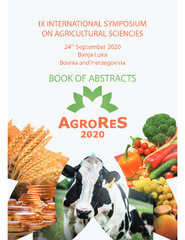Приказ основних података о документу
Genetic diversity of maize inbred lines assessed by SSR markers
| dc.creator | Ristić, Danijela | |
| dc.creator | Kostadinović, Marija | |
| dc.creator | Kravić, Natalija | |
| dc.creator | Kovinčić, Anika | |
| dc.creator | Stevanović, Milan | |
| dc.creator | Savić, Iva | |
| dc.creator | Nikolić, Milica | |
| dc.date.accessioned | 2022-06-30T07:15:56Z | |
| dc.date.available | 2022-06-30T07:15:56Z | |
| dc.date.issued | 2020 | |
| dc.identifier.isbn | 978-99938-93-63-9 | |
| dc.identifier.uri | http://rik.mrizp.rs/handle/123456789/977 | |
| dc.description.abstract | Morphological traits are the earliest used markers in germplasm characterization, but their application may be difficult due to the presence of recessive homozygous alleles and their low frequency. Simple Sequence Repeat (SSR) markers are widely used for estimation of genetic diversity within different species, due to their reproducibility, informativeness co-dominant and multi-allelic nature. They are also most effective for evaluation and selection of plant material, as well as assessment of genetic variability and relatedness of maize inbred lines. The aim of our work was to evaluate genetic diversity of maize inbred lines by SSR markers and compare results with their pedigre information. Seventeen polymorphic SSR markers were used to characterized 23 maize inbred lines that belong to diferent breeding programs. A total number of detected alleles was 78 and varied between two to nine, with an average of 4.6 alleles per marker. Based on presence or absence of alleles in each sample coefficient of similarity was calculated by Jaccard in NTSYSpc2 program package, version 2.1. The highest value (0.88) of genetic similarity was calculated between L21 and L22, while the lowest value (0.18) was found between inbred lines L3/L16 and L15/L20. Genetic similarity matrix was used to construct dendrogram by UPGMA (Unweighted Pair Group Method with Arithmetic Mean) method. Dendrogram analysis grouped maize inbred lines in one large cluster with 21 analyzed genotypes and one smaller cluster with two lines. Genetic heterogeneity betweean inbred lines detected by selected set of SSR markers, makes them a good choice for genetic diversity analysis and planning maize breeding programs. | sr |
| dc.language.iso | en | sr |
| dc.relation | info:eu-repo/grantAgreement/MESTD/Technological Development (TD or TR)/31068/RS// | sr |
| dc.rights | openAccess | sr |
| dc.rights.uri | https://creativecommons.org/licenses/by/4.0/ | |
| dc.source | 9. International symposium on agricultural sciences "AgroReS 2020", 24.09.2020., Banja Luka, B i H – Book of Abstracts | sr |
| dc.subject | maize inbred lines | sr |
| dc.subject | genetic similarity | sr |
| dc.subject | SSR markers | sr |
| dc.subject | zea mays l | sr |
| dc.title | Genetic diversity of maize inbred lines assessed by SSR markers | sr |
| dc.type | conferenceObject | sr |
| dc.rights.license | BY | sr |
| dc.citation.spage | 42 | |
| dc.identifier.fulltext | http://rik.mrizp.rs/bitstream/id/4764/agrores2020.pdf | |
| dc.identifier.rcub | https://hdl.handle.net/21.15107/rcub_rik_977 | |
| dc.type.version | publishedVersion | sr |


